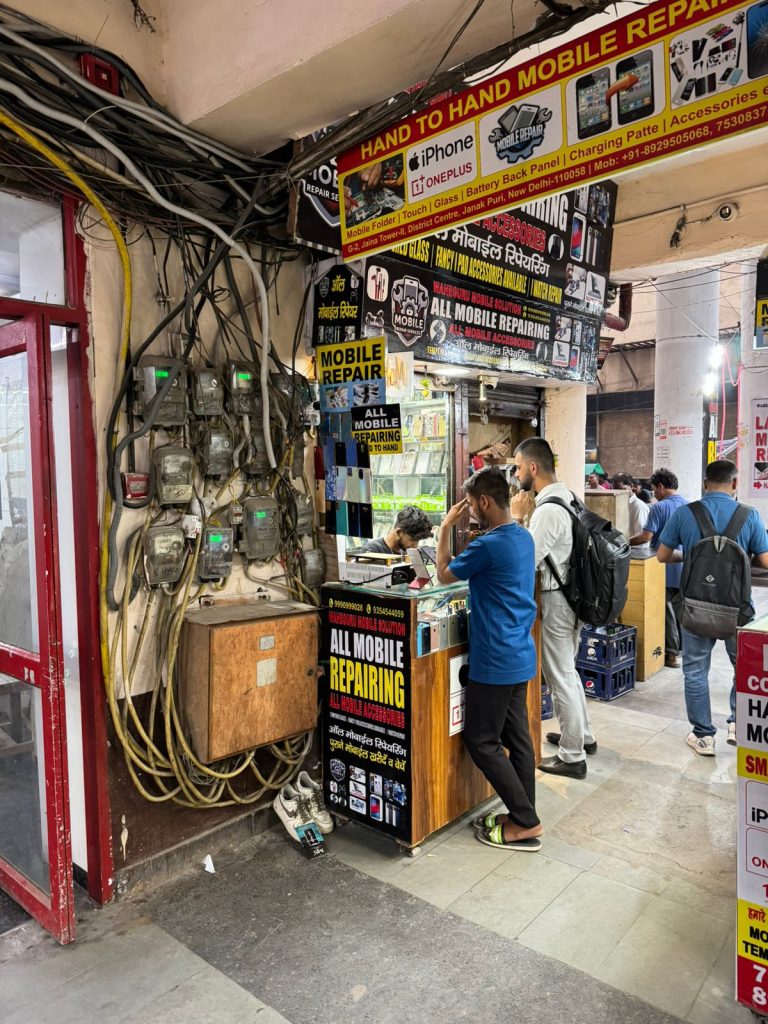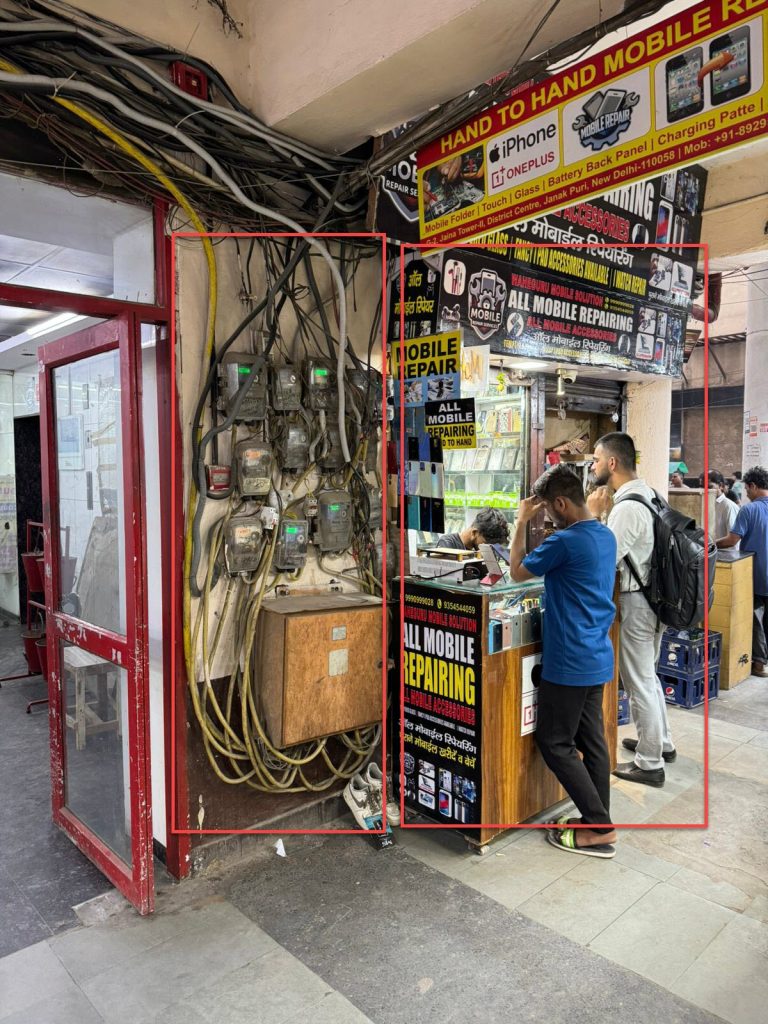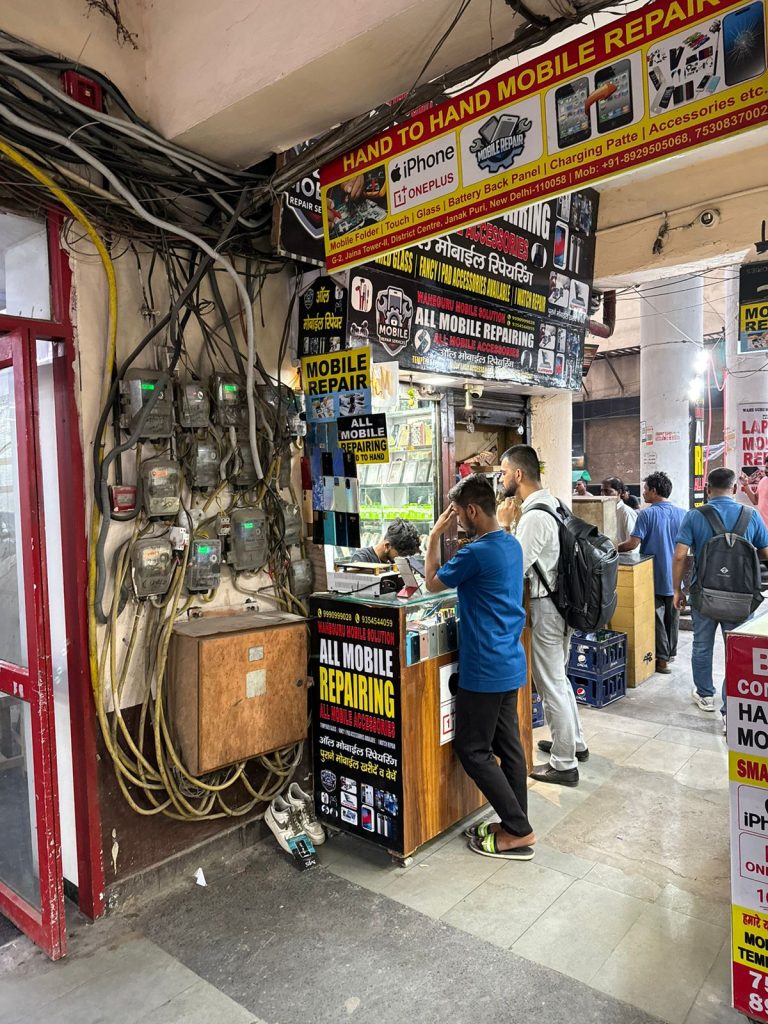1. What the Photo Shows – and Why It Matters



That colourful plywood kiosk in your line of sight is not a cute convenience. It is an unapproved shop grafted onto a structural column, wedged between the main doorway and the tower’s electrical distribution board. Every visitor entering or exiting must brush past:
- Exposed, aging wiring hanging inches from metal display shelves.
- Live energy meters that should be kept clear for maintenance and fire-safety clearance.
- Constant foot-traffic bottlenecks, blocking one of the building’s few evacuation paths.
With batteries, solvents and soldering irons routinely in use, the stall turns an already over-loaded electrical nook into a potential ignition chamber.
2. From 31 Shops to 65: How Did We Get Here?
Jaina Tower’s original completion certificate (26 Nov 1999) approved 31 ground-floor shops. A Delhi Development Authority (DDA) survey on 13 May 2025 counted 65. The difference didn’t appear by magic; it came from incremental encroachment—brick-by-brick, shutter-by-shutter—into common corridors, refuge areas, and even utility shafts. This kiosk is just one example of the “refuge-area flip”: space that should be vacant in emergencies repurposed and sold/rented for profit.
3. Why This Particular Stall Is Extra Dangerous
| Risk Factor | What’s Happening | Real-World Consequence |
|---|---|---|
| Proximity to meters | Less than 30 cm clearance from live panels | Surge + flammable mobile parts = instant flash fire |
| Blocked egress | Queue spills into corridor | Evacuation time balloons during an emergency |
| Improvised wiring | Cables draped over sharp plywood edges | Short-circuit, arc or trip hazard |
| No Fire NOC in the past | Jaina Tower’s fire approval lapsed; electricity was cut for 2+ months in 2022 | High-rise fires spread fastest through utility shafts |
Remember the 2022 electricity disconnection? The fire department pulled the plug precisely because basic safety norms around these very meters were ignored. Re-energising the tower without removing such hazards defeats the entire exercise.
4. The Legal Angle
- Delhi Building By-laws 2016 demand 1.2 m clear corridors for commercial premises—violated here.
- Fire Service Rules prohibit combustible stalls within 1 m of mains panels—violated.
- Sale/Rent Contracts for unapproved structures have no legal standing; both seller and buyer risk demolition orders, fines and even criminal prosecution under Section 466 of the DMC Act.
If a short-circuit sparks a blaze, insurance companies can refuse claims, citing “material alteration” and “wilful negligence.”
5. Who Bears the Cost?
- Visitors & employees: Injury, loss of life, property damage.
- Legitimate shop-owners: Higher insurance premiums, reputational hit.
- Residents & investors: Falling property values and a growing stack of litigation.
- The city: Fire-service resources diverted, DDA forced into never-ending sealing drives.
6. What Must Happen Next
- Immediate sealing of the kiosk by DDA’s Building Department and BSES (utility) joint task-force.
- Electrical audit to inspect meters, replace singed wiring, and restore safe clearances.
- Updated evacuation plan posted at all entrances once corridors are cleared.
- Public disclosure: display the original completion-certificate layout in the lobby so visitors can recognise illegal encroachments.
- Zero-tolerance enforcement for any new “temporary” stalls—no power connection, no licences, no excuses.
7. Call to Action
- Visitors: Refuse service at kiosks that compromise safety; speak up to the RWA/management.
- Occupants: Document hazards (photos, dates) and lodge written complaints with DDA, DFS (Delhi Fire Service) and the local police station.
- Authorities: Enforce the 13 May 2025 survey findings—issue demolition notices where due and follow through.
- Media & bloggers: Keep a spotlight on illegal floor area ratios (FAR) inflation inside Jaina Tower; public scrutiny saves lives.
Final Thought
Convenience should never come at the cost of safety. The mobile-repair kiosk may earn a few thousand rupees a day, but the hidden cost could be catastrophic. Clearing it—and every other unapproved unit—restores not just compliance but basic peace of mind for everyone who steps into Jaina Tower.